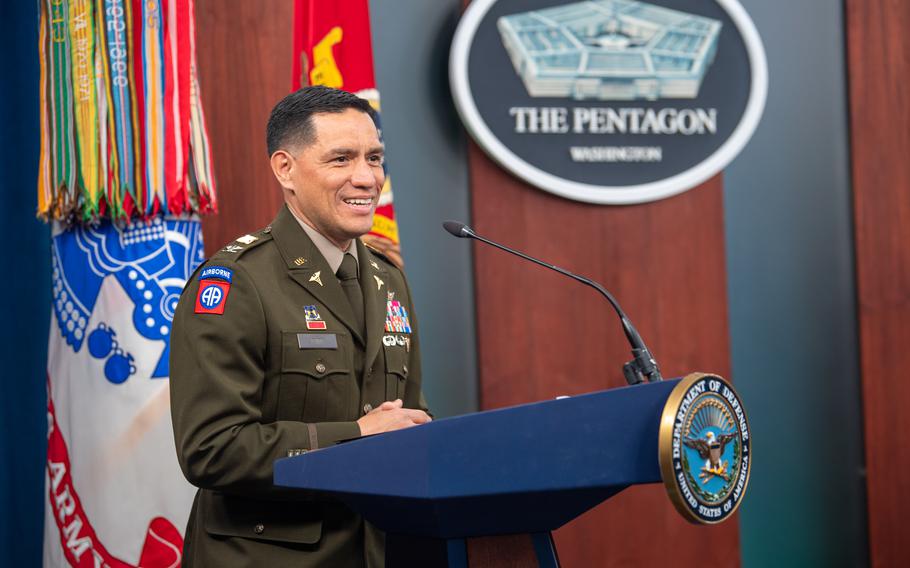
Army Col. Frank Rubio, a NASA astronaut, addresses the audience after receiving the Army Astronaut Device on Thursday, Feb. 22, 2024, during a ceremony at the Pentagon. Rubio holds the U.S. record for the most days in space for a single spaceflight, serving 371 days aboard the International Space Station. (Deonte Rowell/U.S. Army)
WASHINGTON — Army Col. Frank Rubio did not grow up thinking he would end up in space. It was something he gravitated to later in life.
“You kind of fall in love with the idea of, ‘Hey, I get to go out and explore space, do something really challenging and hard,’ ” he said. “[There are] few things where you can say my job represents humanity. And that’s a pretty powerful thing to be a part of.”
Rubio has been back on Earth for nearly five months and Thursday received the Army Astronaut Device, making him only the third active-duty soldier authorized to wear it, according to the service.
“The biggest honor for me about this badge is that, to me, it is the ultimate team badge,” he said. “You absolutely cannot get to space on your own.”
Rubio was in space for 371 days, which set the U.S. record for longest continuous spaceflight when he landed Sept. 27.
Rubio graduated from West Point in 1998 and earned his doctorate of medicine from the Uniformed Services University of the Health Sciences in Bethesda, Md., in 2010. Prior to attending medical school, he served as a UH-60 Black Hawk helicopter pilot and flew more than 1,100 hours, including more than 600 hours of combat time during deployments to Bosnia, Afghanistan and Iraq.
Prior to being selected by NASA as part of the 2017 Astronaut Candidate Class, Rubio was a surgeon for the 3rd Battalion with the 10th Special Forces Group at Fort Carson, Colo.
He spent two years training as an astronaut candidate to be a flight engineer and member of the Expedition Crew 68, according to his NASA biography.
Rubio, along with Russian cosmonauts Sergey Prokopyev and Dmitry Petelin, launched Sept. 21, 2022, on the Soyuz MS-22 spacecraft from the Baikonur Cosmodrome in Kazakhstan to the International Space Station. He and his crew members were only supposed to be in space for six months. A coolant leak on the vessel required NASA and Russian space agency Roscosmos to send the three men a replacement spacecraft for their ride home, delaying the arrival of a new team of astronauts to relieve them.
During the mission, Rubio traveled more than 157 million miles, according to his NASA biography. He conducted three spacewalks, totaling more than 21 hours of space walking time.
“I will just say, clearly, we have an underachiever,” Army Secretary Christine Wormuth joked at a ceremony. “In all seriousness, Col. Rubio has a powerful U.S. Army story to tell. You are a stellar example of the Army’s core values and what it means to lead a life of service.”
Rubio told reporters after the ceremony that he will remain a part of NASA and hopes to fly again in the future.
“Just getting on a rocket and being on 300 tons of rocket fuel is a pretty incredible feeling,” he said. “I got to fly with 28 other people in space. And given that there’s been a little over 600 human beings that have ever been to space, to fly with that many and get to know them on a personal level up there, that was a pretty unique experience and something that I’ll always treasure.”
The Army Aviation Badge with Astronaut Device is shown before U.S. Army Col. Frank Rubio received it during a ceremony at the Pentagon, Thursday, Feb. 22, 2024. Rubio holds the U.S. record for the most days in space for a single spaceflight, serving 371 days aboard the International Space Station. (Deonte Rowell/U.S. Army)